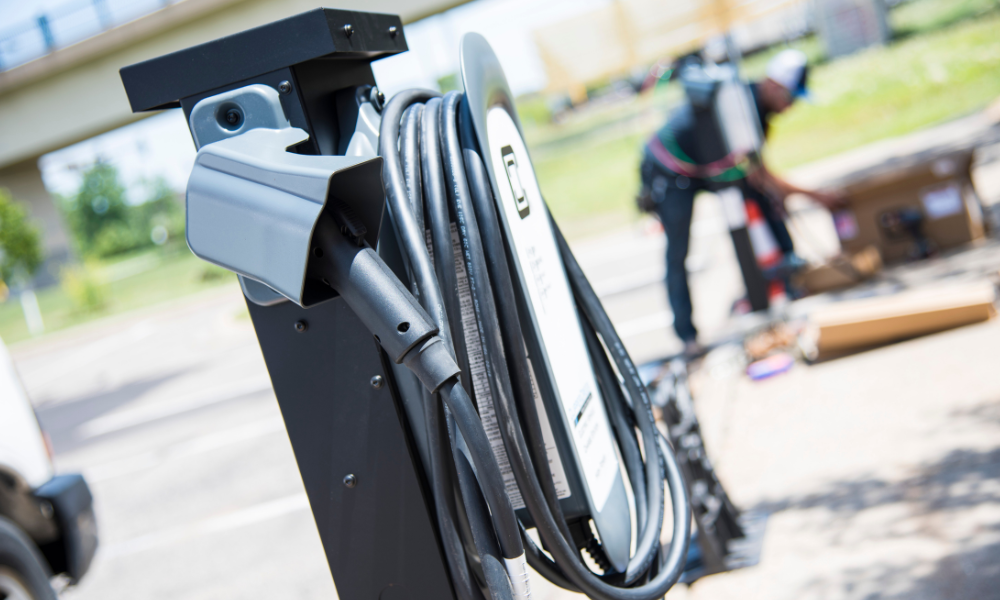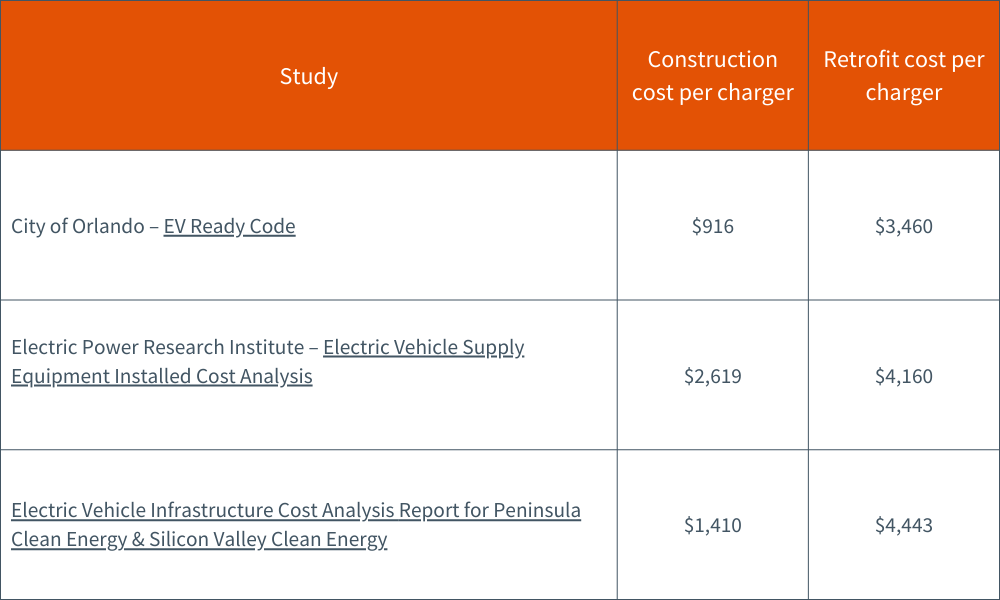Electric Vehicle-Ready Parking 101
April 6, 2023 | M. Moaz Uddin | Education

Electric vehicle-ready building codes and ordinances help expand charging infrastructure
Minimum electric vehicle-ready building codes and ordinances support the expansion of electric vehicle charging infrastructure, which is critical to reducing range anxiety and spurring electric vehicle deployment. Installing infrastructure during new construction also prevents the need for costly retrofits, including breaking and repairing walls, installing longer electric wires and conduits, and using more expensive methods of upgrading service panels. When included in initial construction, they can significantly reduce installation costs.
Examples of cost savings from new construction vs. retrofits
Numerous studies have explored the cost difference between new construction vs. retrofits regarding electric vehicle infrastructure. The City of Orlando, Florida, highlighted a local electric vehicle-ready building cost example prior to the passage of the city’s electric vehicle-ready ordinance in 2021. It found that including 20 percent electric vehicle charger-capable and 2 percent electric vehicle charger-installed parking spots contributed to .0009 percent of total new construction project costs for a 116-unit affordable multi-family housing dwelling. The city estimated that efforts to include electric vehicle infrastructure in new construction can save 75 percent compared to retrofit costs to make parking electric vehicle-ready.
Studies showing the cost difference between new construction and retrofits for electric vehicle charger installation

Sources:
City of Orlando, “EV Ready Code” (presentation, March 17, 2021), 30, https://www.orlando.gov/files/sharedassets/public/departments/edv/accc-ev-ready-commissioner-briefings_updated.pdf
Electric Power Research Institute, “Electric Vehicle Supply Equipment Installed Cost Analysis,” (technical report, December 2013), B-9, https://www.epri.com/research/products/000000003002000577
Tim Minezaki, Cassidee Kido, and Ed Pike, Electric Vehicle Infrastructure Cost Analysis Report for Peninsula Clean Energy (PCE) & Silicon Valley Clean Energy (SVCE), Energy Solutions, November 20, 2019, https://bayareareachcodes.org/wp-content/uploads/2020/03/PCE_SCVE-EV-Infrastructure-Report-2019.11.05.pdf.
State and local government roles
The state Department of Labor and Industry’s Construction Codes and Licensing Division administers the building code in partnership with the local government. While the department regularly updates the code, the legislature can also amend it by creating new regulations or changing how the existing codes apply within Minnesota.
Local governments can enforce zoning ordinances to ensure that new construction in their jurisdiction meets the anticipated needs of users. While the local zoning ordinances can influence development in many ways, including determining permitted land uses, setting minimum requirements for construction, and setting safety and signage requirements, they cannot supersede the Minnesota building code. The Minnesota building code currently does not cover electric vehicle readiness.
Accessibility considerations
The Americans with Disability Act requires that site developers installing electric vehicle charging stations follow special design guidelines to accommodate people with disabilities. While the Americans with Disability Act does not provide design standards for charging station-equipped parking spots, the Minnesota Pollution Control Agency has issued guidance on the minimum standards that should be kept in mind when installing infrastructure to avoid expensive retrofits later.
Benefits of expanding access to electric vehicle charging
Incorporating electric vehicle infrastructure benefits many different users, including but not limited to residents, employees, and tourists.
As stated in The Washington Post, 80 percent of electric vehicle charging happens at home. This makes it challenging for residents without access to home charging. The National Renewable Energy Laboratory estimates that only half of all vehicles in the United States belong to residents of single-family or duplex homes with dedicated parking appropriate for overnight electric vehicle charging.
Publicly accessible electric vehicle charging at city centers, shopping plazas, and parking ramps can provide tourists and residents with convenient vehicle charging locations in these high-traffic areas. This can attract tourists and elevate cities and towns to electric vehicle road trip destinations. The City of Red Wing, Minnesota, installed a free public-facing fast charger to cater to tourists.
Downloadable fact sheets
Download our fact sheets tailored to different audiences below!
